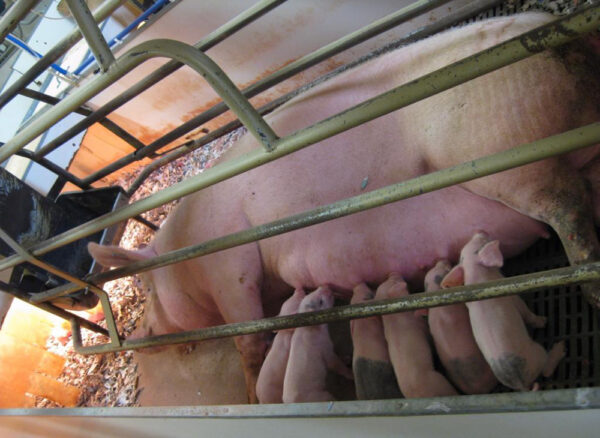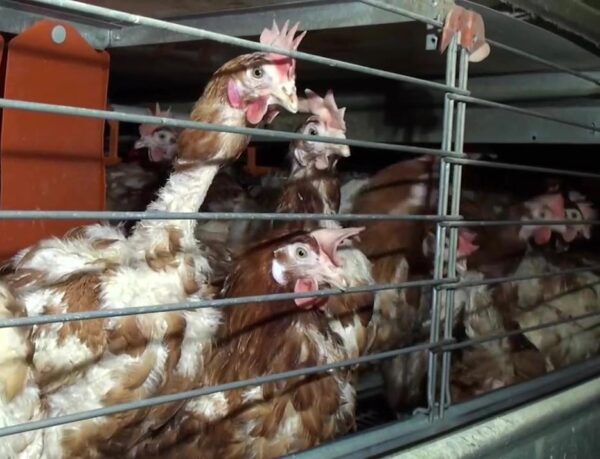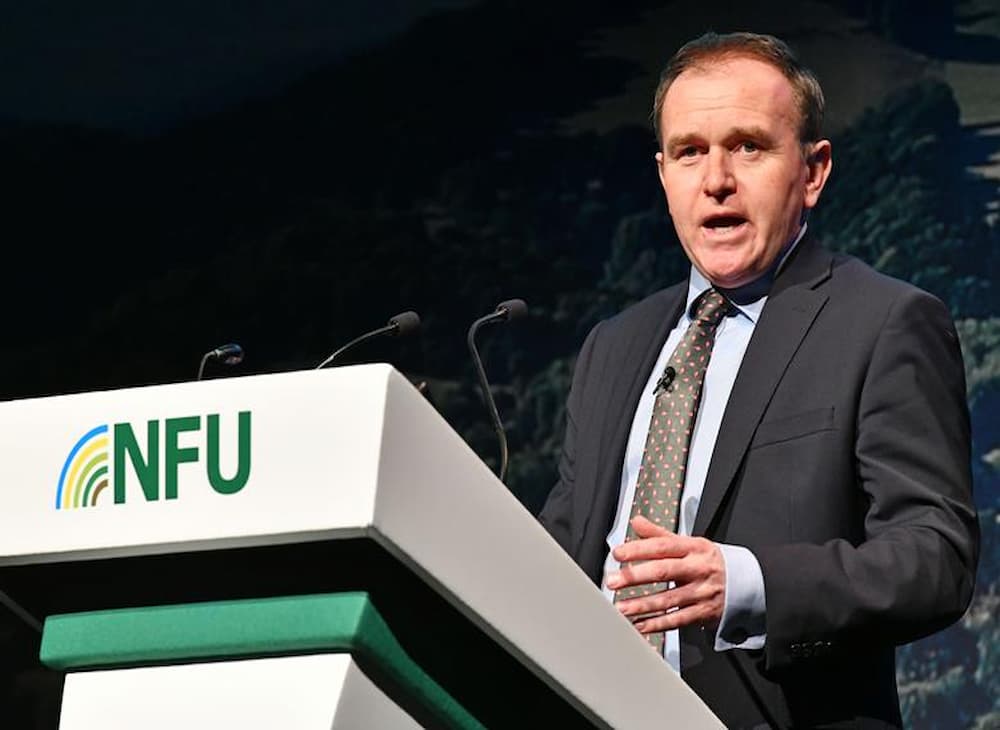The Conservative Animal Welfare Foundation welcomes this initiative to advance farm animal health and welfare. Defra is considering the case for introducing reforms, such as the use of farrowing crates for pigs and enriched cages for laying hens.” The Animal Health and Welfare Pathway- It supports farmers to transition to higher welfare practices and systems
On pigs, the Pathway priorities include:

- reduce sow confinement during farrowing by supporting producers in shifting to less confined alternatives for the sow, whilst ensuring the welfare of her piglets and the safety of workers. Exploring potential reforms around the use of farrowing crates, which can restrict sows’ normal behaviours such as, nesting
- reduce stressors to keep tails intact: to support farmers in addressing the underlying causes of high stress levels in pigs which trigger tail biting, such as, poor environmental enrichment, so that farmers feel confident to not dock tails

On laying hens, the Pathway priorities include:
- transition out of cages: Defra are exploring potential reforms around the use of enriched cages for laying hens, which can restrict hens’ normal behaviours such as dustbathing – the Pathway will support producers shifting away from their use
- improve feather cover management: to support farmers to address the underlying root causes of feather pecking, reducing the need for infra-red beak trimming
- improve keel bone health to reduce laying hens’ susceptibly to painful fractures which can occur in all production systems
On Broiler Poultry, priorities are to:
- implement the Better Chicken Commitment which requires slower-growing breeds, lower stocking densities and restrictions on thinning birds. These all contribute to improved health and welfare outcomes, such as fewer leg disorders
- adopt welfare-improving technology to support environmental and behavioural monitoring and better stockmanship
On cattle (beef and dairy), priorities are to:
- tackle Bovine Viral Diarrhoea which costs the industry an estimated £14 million each year and raises greenhouse gas emissions from cattle
- reduce lameness and mastitis to improve health and welfare, increase productivity and decrease the environmental impacts of farming
- upgrade housing: many farm buildings are not optimally designed for cattle, especially calves – encourage improvements in ventilation, cow comfort, loafing areas and enrichments such as scratching brushes
- improve pain management during disbudding, dehorning and castration through greater adoption of prolonged analgesia to improve the welfare and performance of calves
- improve the welfare of cattle at pasture through improvements in shelter, drainage, gateways and tracks that support the normal behaviours associated with grazing and being outdoors
On sheep, priorities are to:
- tailor health screening to address a range of endemic diseases, estimated to cost the sector around £85 million each year – initially this will focus on internal and external parasites (and associated anthelmintic resistance), mastitis, ‘iceberg’ diseases and those inducing abortion
- reduce lameness as it is one of the most common signs of ill health and discomfort among sheep, affecting animals’ mobility, productivity and longevity
- better ewe sustainability, optimising body condition so that ewes are less susceptible to disease, produce better quality milk and can rear a greater number of healthier lambs
- improve pain management during castration and tail docking: we want to support the licensing and uptake of pain relief to reduce the impact of these procedures
Whether it be: upgrading housing for cattle to deliver improvements in lameness, cow comfort and calf mortality; working with farmer’s vet to control key endemic diseases affecting their flock; gradually moving hens to cage-free environments; or improving biosecurity on pig units, Defra have designed the Pathway so that their priorities cover something applicable to most farms.
Speaking at the NFU Conference in February 2022, George Eustice set out plans for government-funded vet visits, grants for welfare improvements, and health and welfare priorities for each sector.
Farmers will be encouraged to keep healthier, higher welfare animals as part of the Government’s flagship farming reforms, including fully-funded annual vet visits and grants to improve conditions for livestock.
During his speech at the National Farmers Union conference, Environment Secretary George Eustice outlined his vision for internationally competitive livestock sectors. He set out plans for the Animal Health and Welfare Pathway – a programme of financial support for farmers in the pig, cattle, sheep and poultry sectors, based around key animal health and welfare priorities.
These include measures such as reducing mastitis and lameness in dairy cattle, improving biosecurity to control pig diseases endemic to the UK and improving the feather cover of laying hens. To help farming sectors make these improvements, Animal Health and Welfare Grants will be launched within the next year to fund investments such as equipment and technology or larger projects like upgrading housing for dairy cattle to deliver improvements in lameness, cow comfort and calf mortality.
As part of the Pathway, the Government will initially offer cattle, sheep and pig farmers who are eligible for the Basic Payment Scheme funding for an annual visit from a vet of their choice to carry out diagnostic testing, review biosecurity and responsible use of medicines, and provide advice relating to the health and welfare of their animals. These visits will launch later this year (2022) and the offer will be further extended over time to other types of livestock farmers.
The Animal Health and Welfare Pathway will also include a disease eradication and control programme. This will allow farmers to apply for financial support to enable them to take measures to prevent and reduce endemic diseases affecting livestock such as veterinary advice, vaccination, or improvements to on-farm management.
We plan to trial a payment by results programme. This would mean rewarding farmers who can demonstrate high animal health and welfare outcomes, such as those such as those who provide their animals ample space and enrichment so they can better express their natural behaviours.
Environment Secretary, George Eustice said:
The Animal Health and Welfare Pathway is for those farmers who are in pursuit of higher profitability through better health outcomes, and it starts with an annual vet visit.
Farmers will be able to have a vet of their choice, the family vet that they trust, and the government will pay. That vet will be able to help the farmer put together a plan for improved animal health and improved profitability on their livestock holding.
Chief Vet, Christine Middlemiss said:
I hope to see wide-scale adoption of the Annual Health and Welfare Review as part of normal business practice, more farmers taking action to improve health and welfare, and improved outcomes when it comes to endemic diseases and conditions – which will improve animal health welfare and reduce waste, antibiotic use and financial losses.
Outside the EU’s Common Agricultural Policy, the Government is designing a new, fairer farming system that works in the best interests of farmers. The Pathway is a critical part of the farming reforms set out in the Agricultural Transition Plan to promote the production of healthier, higher-welfare animals.
Farmers in England already achieve some of the highest welfare standards in the world and the new measures will support industry as they adapt to global health challenges like antimicrobial resistance, zoonotic disease outbreaks, the race to Net Zero, and biodiversity loss. The reforms will deliver benefits for animal health and welfare, farm productivity, food security, public health, UK trade and the environment.
Further information on how livestock farmers can apply for the first step of the Animal Health and Welfare Pathway, the Annual Health and Welfare Review, will be shared in the Spring. Farmers will have the opportunity to influence the items that are included within the Animal Health and Welfare grants equipment and technology list. Further information on how to take part will be disseminated through representative industry organisations.
Further information
The Pathway is about more than just financial assistance and consists of three mutually reinforcing strands which will:
- support livestock farmers financially by using public funds to pay for health and welfare enhancements that are valued by the public and not currently delivered sufficiently by the market or through existing regulatory standards.
- stimulate market demand for higher welfare products by making it easier for consumers to purchase food that aligns with their values, improving transparency, and providing the industry with a level playing field to promote such products. We are looking at potential market interventions – such as labelling (recent call for evidence) and mandatory public disclosure – that could improve the accessibility, availability, and affordability of higher welfare products for consumers, while driving positive procurement choices by retailers.
- strengthen the regulatory baseline over time, making sure we maintain our current high standards and continue to raise them where necessary, with details subject to consultation with all relevant sectors.
The Vet Visit
This will pay for 2-3 hours of farmer and vet time to: look at the health and welfare of their animals, including biosecurity and responsible use of medicines; receive a report from the vet, which will include some achievable actions the farmer can take to improve health and welfare – this will not be shared with the Government, and is between the farmer and vet; advice on action to take resulting from testing; and signposting to other support, including future grants and disease control schemes.
What is the Animal Health and Welfare Pathway? Defra explains:
The Pathway involves 3 mutually reinforcing strands. From the Government website on this initiative: https://www.gov.uk/government/publications/animal-health-and-welfare-pathway/animal-health-and-welfare-pathway
1. Financially rewarding farmers who deliver public goods
As Direct Payments decline, we will reinvest some of the money to support the production of healthier, higher welfare animals. We will provide incentives for farmers to go above the regulatory baseline and reward higher animal health and welfare on the farm. We will focus on improvements which are valued by the public but not sufficiently delivered by the market.
What’s new? (update February 2022)
We will launch the Annual Health and Welfare Review in 2022 as part of the Sustainable Farming Incentive. This fully funded vet visit will be the first step on the Pathway for many farmers.
Rollout of our other financial support – animal health and welfare capital grants, disease eradication and control programmes, and payment-by-results – will follow. The Pathway is a long-term project that will evolve based on the successes it achieves.
See the funding programmes for more details.
2. Stimulating market demand for higher welfare products
The majority of consumers value high animal welfare, but this is not fully reflected in what they purchase. We want to make it easier for consumers to purchase food that aligns with their values, by improving transparency and providing the industry with a level playing field to promote such products.
We are looking at potential market interventions such as, labelling and mandatory public disclosure that could improve the accessibility, availability and affordability of higher welfare products for consumers, while driving positive procurement choices by retailers.
This can ensure that the price farmers receive for higher welfare products reflects the value the market attaches to them and that sales reflect true market demand. Unlocking this existing demand means that public money can be more effectively directed to animal welfare interventions which are not yet valued by the market.
What’s new? (update February 2022)
We recently launched a labelling for animal welfare: call for evidence. This sought information to help assess the possible impacts, costs and deliverability of different types of labelling reforms for animal welfare. It also explored how we could build on existing voluntary assurance schemes.
The call for evidence closed on 6 December 2021. Responses will feed into the government’s wider work on food labelling and the Food Strategy White Paper.
3. Strengthening the regulatory baseline
We plan to strengthen delivery of the regulatory baseline by improving compliance with our current high standards. Where it is appropriate to raise the bar we will do this in consultation with all relevant sectors and provide sufficient notice of changes so that farmers can plan properly.
We will provide capital grants, partnering with farmers, to transition to a new standard in cases where this delivers good value for money. We want to ensure our future standards are outcomes-focused wherever possible and are subject to less burdensome checks as part of a trust-based relationship between farmers and government.
What’s new? (update February 2022)
We are considering the case for introducing reforms, such as the use of farrowing crates for pigs and enriched cages for laying hens.
The Animals (Penalty Notices) Bill is currently passing through Parliament. This will give powers to issue penalties to those not complying with animal health and welfare regulations.
Later this year we will be publishing further information on our new approach to regulation and enforcement outside the EU.
What we want to achieve
The Pathway is central to the government’s manifesto commitment to protect and enhance farm animal health and welfare, and to maintain and build on our existing world-leading standards. It supports several government strategies by:
- supporting farmers to transition to higher welfare practices and systems and encouraging sustainable food production founded upon high-welfare farming – Action Plan for Animal Welfare
- improving biosecurity, which will help manage endemic disease risk and further support our goal to eradicate bovine tuberculosis by 2038
- tackling anti-microbial resistance, as set out in the UK 5-year action plan for antimicrobial resistance
- reducing greenhouse gas emissions from livestock through tackling diseases and improving productivity, supporting the Net Zero Strategy and the 25 Year Environment Plan
Health and welfare priorities
The primary goal of the Pathway is to improve farm animal health and welfare across our national herds and flocks. To deliver gradual, yet continual improvement, the Pathway will focus on providing a clear set of priorities that reflect some of the very best opportunities for improving animal health and welfare.
These priorities will guide development of the Pathway, shaping the advice given, information collected and capital grants offered. We will review priorities as we progress along the Pathway, working collaboratively with industry to adapt and learn as we go.
What’s new? (update February 2022)
We have determined animal welfare priorities for each livestock sector on the Pathway through co-design with industry, vets, non-government organisations and welfare scientists. We reached collective agreement on most priorities; some represent compromises between differing stakeholder views. These are presented below alongside priority endemic diseases and conditions published in the Agricultural Transition Plan in November 2020.
Supporting better stockmanship, particularly through training, will be an overarching priority across all sectors, as a critical enabler for good health and welfare.


